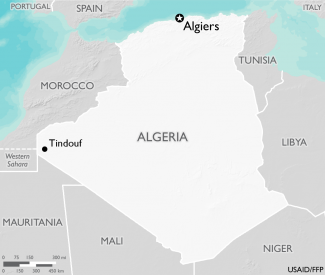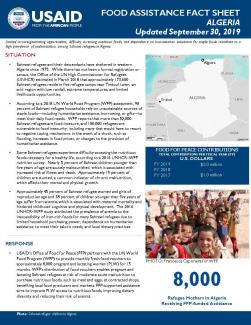September 30, 2019
Limited income-generating opportunities, difficulty accessing nutritious foods, and dependence on humanitarian assistance for staple foods contribute to a high prevalence of undernutrition among Sahrawi refugees in Algeria.
Situation
- Sahrawi refugees and their descendants have sheltered in western Algeria since 1975. While there has not been a formal registration or census, the Office of the UN High Commissioner for Refugees (UNHCR) estimated in March 2018 that approximately 173,600 Sahrawi refugees reside in five refugee camps near Tindouf town, an arid region with low rainfall, extreme temperatures, and limited livelihoods opportunities.
- According to a 2018 UN World Food Program (WFP) assessment, 90 percent of Sahrawi refugee households rely on unsustainable sources of staple foods—including humanitarian assistance, borrowing, or gifts—to meet their daily food needs. WFP reports that more than 52,000 Sahrawi refugees are food-insecure, and 100,000 refugees are vulnerable to food insecurity, including many that would have to resort to negative coping mechanisms in the event of a shock, such as flooding, increases in food prices, or changes to the provision of humanitarian assistance.
- Some Sahrawi refugees experience difficulty accessing the nutritious foods necessary for a healthy life, according to a 2016 UNHCR–WFP nutrition survey. Nearly 5 percent of Sahrawi children younger than five years of age are acutely malnourished, which is associated with increased risk of illness and death. Approximately 19 percent of children are stunted, a common indicator of chronic malnutrition, which affects their mental and physical growth.
- Approximately 45 percent of Sahrawi refugee women and girls of reproduction age and 38 percent of children younger than five years of age suffer from anemia, which is associated with maternal mortality and hindered childhood cognitive and physical development. The 2016 UNHCR–WFP study attributed the prevalence of anemia to the inaccessibility of iron-rich foods for many Sahrawi refugees due to limited household purchasing power, dependence on humanitarian assistance to meet their caloric needs, and local dietary practices.
[[nid:338211]]
Response
- USAID’s Office of Food for Peace (FFP) partners with the UN World Food Program (WFP) to provide monthly fresh food vouchers to approximately 8,000 pregnant and lactating women (PLW) for 15 months. WFP’s distribution of food vouchers enables pregnant and lactating Sahrawi refugees at risk of moderate acute malnutrition to purchase nutritious foods, such as meat and eggs, at contracted shops, benefiting local food producers and markets. FFP-supported assistance aims to improve PLW access to nutritious foods, improving dietary diversity and reducing their risk of anemia.
Food for Peace Contributions
Total Contributions:
| U.S. Dollars | Metric Tons | |
|---|---|---|
| Fiscal Year 2019 | $2.0 million | ---- |
| Fiscal Year 2018 | ---- | ---- |
| Fiscal Year 2017 | $1.0 million | ---- |
Image

Document

